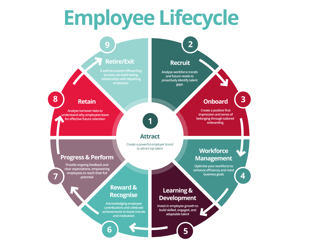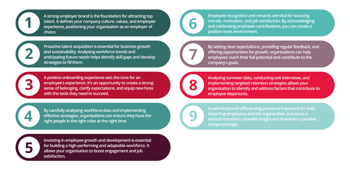
What is an employee lifecycle?
The employee lifecycle outlines an individual's journey within an organisation. This typically starts from their initial interest in an organisation, to their eventual departure. It encompasses 9 key stages, including:
- Attract
- Recruit
- Onboard
- Workforce Management
- Learning & Development
- Reward and Recognise
- Progress & Perform
- Retain
- Retire/Exit
By understanding and optimising each phase of the employee lifecycle model, organisations can enhance employee satisfaction, boost productivity, and strengthen their employer brand. It’s about creating a positive and rewarding employee experience from start to finish.


Why is the employee lifecycle important?
A well-executed employee lifecycle model is the cornerstone of a high-performing organisation. By optimising each stage of the lifecycle, businesses can improve performance whilst strengthening their employer branding. Closely overseeing each stage can help reduce turnover by ensuring employees feel valued. It also ensures that employee goals align with organisational objectives.
View our employee lifecycle toolkit
Transform your employee experience with our actionable toolkit which will help you identify key activities for each stage of the employee lifecycle.
The 9 stages of the employee lifecycle
1. Attract
HR departments play a pivotal role in transforming organisations into sought-after employers. Creating a compelling employer brand will differentiate an organisation in the job market. Our Employer Branding Strategy template can give you some helpful ideas to help foster a brand employees look for. Simultaneously, building a strong talent pipeline ensures a steady stream of qualified candidates. This both reduces time-to-hire and improves the quality of hires.
Leveraging data-driven insights helps identify top talent and tailor recruitment efforts accordingly. A robust Applicant Tracking System (ATS) is essential for managing the recruitment process efficiently. ATS streamline recruitment, provide insights, and facilitate a transition to the next stage of the employee lifecycle: onboarding.
2. Recruit
Recruitment in large organisations is a diverse process extending far beyond traditional interviews. Effective recruitment requires a coordinated effort to identify, assess, and select top talent. To effectively coordinate your hiring process across your whole organisation, check out our Hiring Process Checklist for helpful tips.
The recruitment process must be strategic. By analysing workforce trends and future needs, organisations can proactively identify talent gaps. This helps build robust talent pipelines.
Leveraging social media, employee referrals, and industry partnerships can also expand the candidate pool and increase diversity. By optimising the recruitment process, businesses can build a strong talent pipeline, reduce time-to-hire, and improve the quality of hires.
3. Onboard
Effective onboarding in large organisations requires a delicate balance of personalisation and scalability. Tailoring onboarding to different roles is crucial for creating a positive first impression and a sense of belonging.
HR Technology can help streamline administrative tasks. This allows HR teams to focus on building relationships with their people.
A successful onboarding program ensures new hires integrate seamlessly into the company culture. It provides them with tools and knowledge to succeed in their new roles. This creates a seamless onboarding experience that accelerates productivity and builds employee loyalty. Gathering feedback from your new hires about their onboarding experience is a great way to improve and develop your onboarding processes. Our Onboarding Survey Template features examples of questions you might want to ask.
4. Workforce Management
Effective workforce management plays a vital part in aligning talent with organisational goals. By strategically planning for future needs, identifying high-potential employees, and implementing robust performance management systems, businesses can optimize resource allocation. This helps to enhance overall efficiency.
5. Learning and development
Employee development is essential for retaining talent, fostering adaptability, and future-proofing the workforce. Investing in employee growth builds skilled, engaged, and adaptable talent.
Leadership development programs are crucial for cultivating future leaders and driving organisational success. Investing in these programs develops individual's strategic mindset, interpersonal skills, and decision-making abilities.
6. Reward and Recognise
Effective engagement extends beyond traditional methods. Ongoing feedback and regular check-ins are essential for understanding employee needs. Pulse surveys and employee suggestion boxes provide valuable insights whilst encouraging open communication.
Recognition programs that celebrate achievements are crucial for boosting morale and motivation. Acknowledging employee contributions allows organisations to show their appreciation. Rewards and recognition should be tailored. This helps reinforce desired behaviours and strengthens employee engagement.
7. Progress and Perform
Employee progression and performance is a fundamental part of the employee lifecycle. Having a robust performance management system can help employees aligning their goals with broader business objectives.
Regular feedback, clear expectations, and opportunities for growth encourage high performance and employee engagement.
By offering clear career paths and mentorship programs, employees feel empowered to reach their full potential.
8. Retain
In large organisations, it's easy to overlook the importance of ongoing support for tenured employees. However, retention is a critical function. Significant investments in training and development make employee turnover particularly costly. Losing high-performing talent disrupts operations and risks these individuals' joining competitors.
Understanding why employees leave allows for effective retention. By analysing turnover data, organisations can identify patterns and address underlying issues. Popular strategies for keeping employees include:
- Offering competitive salaries
- Building comprehensive benefits packages
- Prioritise employee well-being through wellness programs, flexible work arrangements, and supportive policies
- Implement a robust recognition program to acknowledge and appreciate employee contributions.
By addressing employee needs and creating a supportive workplace culture, organisations can significantly reduce turnover and retain their top performers.
9. Retire/Exit
A well-structured offboarding process is essential for building lasting relationships with departing employees. By handling these departures with care and respect, organisations can:
- preserve morale among the remaining workforces
- protect their employer brand
- cultivate potential brand ambassadors or boomerang employees.
A smooth offboarding process demonstrates a company's commitment to its employees, even as they leave. It's an opportunity to gather valuable feedback through exit interviews. This allows businesses to address any lingering issues and maintain positive relationships. Former employees with a positive offboarding experience are likely to speak favourably about a company. This in turn helps to attract top talent and returning employees in the future.
Continuous improvement
Data analytics is the cornerstone of optimising the employee lifecycle. By measuring key performance indicators at each stage, organisations can:
- Identify areas for improvement
- Allocate resources effectively
- Make data-driven decisions
For example, analysing time-to-hire metrics can optimise recruitment processes, whilst examining employee engagement scores can inform retention strategies.
Employee feedback is equally crucial. By actively seeking input from employees, organizations can:
- Uncover hidden challenges
- Identify opportunities for growth
- Create a culture of continuous improvement
This approach to continuous improvement encourages culture of innovation and adaptability. This ensures the organisation stays ahead of industry trends and meets the evolving needs of its workforce.
Optimising the employee lifecycle with HR Technology
With HR technology, businesses can automate routine tasks such as payroll and leave requests. This allows HR teams to focus on strategic initiatives that drive business growth.
Having unified HR solutions improves HR efficiency. It eliminates data silos whilst enhancing employee experience. Furthermore, a scalable solution allows businesses to accommodate growth and their evolving needs.
By streamlining processes, HR technology empowers organisations to make data-driven decisions, improve employee engagement, and enhance overall operational efficiency.
Enhance your employee lifecycle model with unified HR
A well-managed employee lifecycle is the cornerstone of a high-performing business. By strategically navigating each stage, organisations can optimise talent acquisition, development, engagement, and retention.
The key to success is a data-driven approach. By leveraging analytics businesses can make informed decisions and measure performance. Employee feedback is equally vital. It helps identify areas for improvement and supports a culture of continuous learning.
By prioritising the employee experience and aligning people strategies with business objectives, organisations can create a high-performing workforce capable of achieving extraordinary results.
Want to know how PeopleXD can help you do the best work of your life by getting the most out of the employee lifecycle? Contact us today or take a look at our handy four-minute demo.